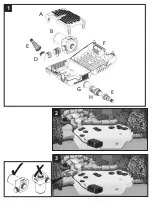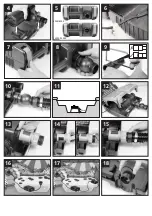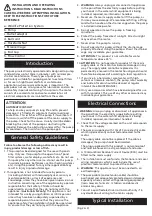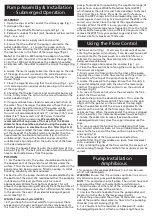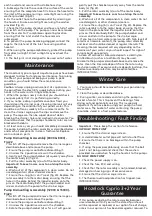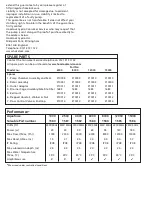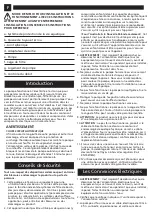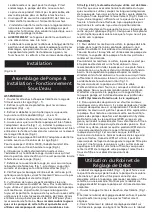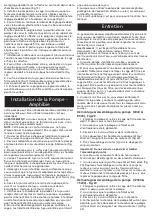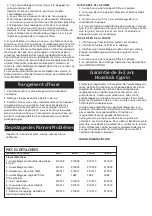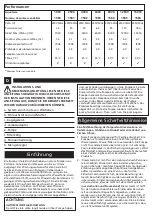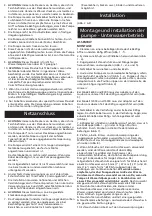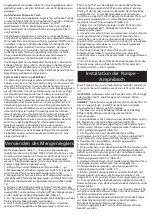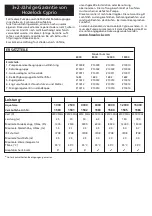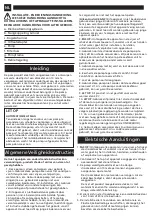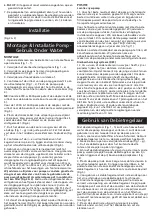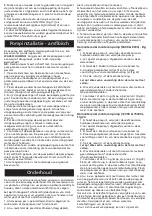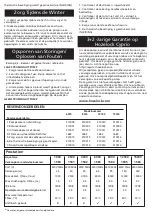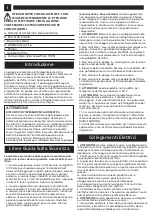
each hosetail and secure with suitable hose clips.
5. Submerge the inlet hose under the surface of the water
ensuring that the complete hose fills. Screw the hosetail to
the inlet of the pump ensuring a watertight seal using the
washer provided (Fig 20).
6. Fix the outlet hose to the pump outlet by screwing on
the hosetail. Ensure a watertight seal using the washer
provided (Fig 21).
7. Check that the pump chamber and hose are full of water
and switch on the pump. The pump can now be removed
from the water to it’s amphibious operating location
ensuring that the inlet end of the hose remains
submerged.
8. To prevent the pump becoming clogged, connect the
cage to the inlet end of the inlet hose using another
hosetail.
9. When using the pump amphibiously, protect the pump
from direct sunlight. Direct sunlight may overheat the
motor.
10. The ball joint is not designed to be used out of water.
The Hozelock Cyprio range of Aquaforce pumps have been
designed to allow fast and easy maintenance. To prolong
the life of your pump and keep your pump in peak
condition, you should follow these maintenance
guidelines.
Caution
: Always unplug or disconnect ALL appliances in
the pond from the electricity supply before putting your
hands in the water or starting maintenance.
1. When the pump is newly installed, you should check
your pump daily that it is performing correctly.
2. If you notice a drop in performance (low flow) you
should clean the strainer cage. Cleaning intervals will vary
depending on the condition of your pond’s water. This
could be as often as weekly in the summer months. To
clean the strainer cage, open the clips and remove the
pump. The cage can then be wiped clean of debris
blocking the strainer holes and washed in clean water. You
should also check that the pump chamber & rotor are not
blocked with debris.
3. At least once a year you should completely disassemble
the pump including the rotor assembly as described below
and wash all components in clean, fresh water. Replace
worn or broken parts.
Pump Dismantling & Assembly (6000 & 8000) -
Fig 22
1. Switch off the pump and remove the strainer cage as
described above and remove the pump.
2. Ensure the pump is cool before dismantling it.
3. Unscrew the 3 posidrive screws in the chamber.
4. Gently pull the pump chamber (d) squarely away from
the motor body (a) (fig 22).
5. Pull the rotor assembly (c) out of the motor body.
Important! Take extra care so as to not drop the rotor
assembly.
6. Wash out all of the components in clean water. Do not
use detergents or other chemical cleaners.
7. Ensure the o-ring (b) is on it’s seat (fig 24). Replace the
rotor assembly into the motor body, ensuring that the
holes in the plate behind the impeller locate onto the
pins on the motor body. Refit the pump chamber and
screws and return the pump to the strainer cage.
Pump Dismantling & Assembly (12000 & 15000) -
Fig23
1. Switch off the pump and remove the strainer cage as
described above and remove the pump.
2. Ensure the pump is cool before dismantling it.
3. Unscrew the 4 posidrive screws in the chamber.
4. Rotate the pump chamber (d) as far as it will go and
gently pull the chamber squarely away from the motor
body (a) (fig 23).
5. Pull the rotor assembly (c) out of the motor body.
Important! Take extra care so as to not drop the rotor
assembly.
6. Wash out all of the components in clean water. Do not
use detergents or other chemical cleaners.
7. Ensure the o-ring (b) is on it’s seat (fig 24). Replace the
rotor assembly into the motor body, ensuring that the
holes in the plate behind the impeller locate onto the
pins on the motor body. Refit the pump chamber and
screws and return the pump to the strainer cage.
4. If you live in a hard water area (water with high levels of
calcium or limescale content), the pump, rotor assembly
and steel can should be cleaned at regular intervals. The
cleaning interval required will vary depending on the
hardness of your water, so you should inspect for signs of
calcium build up regularly.
To clean off calcium or limescale deposits a small nylon
bristled brush (such as a toothbrush) may be used.
Dismantle the pump as described above and remove the
rotor. Clean the limescale deposits from the rotor using
fresh clean water If excessive calcium deposits build up, the
thermal overload protection may be activated (See
INTRODUCTION).
1. Your pump should be removed from your pond during
the autumn.
2. Clean the pump as described above.
3. During winter, we recommend storing the pump in a
bucket of water. This is to prevent the bearings from
drying out and potentially seizing. This is especially
important if you have been using your pump in a hard
water area. The bucket of water containing the pump
should be stored in a frost protected area.
Important
- Please keep this section for reference.
LOW FLOW FROM PUMP
1. Ensure that the strainer cage is clean.
2. A small diameter outlet pipe will restrict outlet flow.
3. Ensure that there is no blockage within the pump
chamber.
4. If using the pump amphibiously, ensure that the ball
joint is not being used and check that the washers
provided are used when fixing the hosetail to the pumps.
NO FLOW FROM PUMP
1. Check the power supply is on.
2. Check the fuse, RCD and wiring.
3. Check that the rotor assembly is not jammed, blocked,
damaged or showing signs of excessive wear.
4. Ensure that the strainer cage is clean.
5. The thermal overload protection has tripped. (see
INTRODUCTION).
If this pump, excluding the rotor assembly, becomes
unserviceable within 3 years of the date of purchase it
will be repaired or replaced at our option free of charge,
unless in our opinion it has been damaged or misused. To
Troubleshooting / Fault Finding
Winter Care
Maintenance
Hozelock Cyprio 3+2 Year
Guarantee
Summary of Contents for Aquaforce 12000
Page 2: ......
Page 3: ...2 3 3 7 A B E D F G H E 1...
Page 4: ...300mm 6 9 12 4 7 10 8 11 5 6000 8000 12000 15000 15 13 14 18 16 17...
Page 5: ...21 19 24 20 23 22 d c b a d c b a...
Page 55: ......



